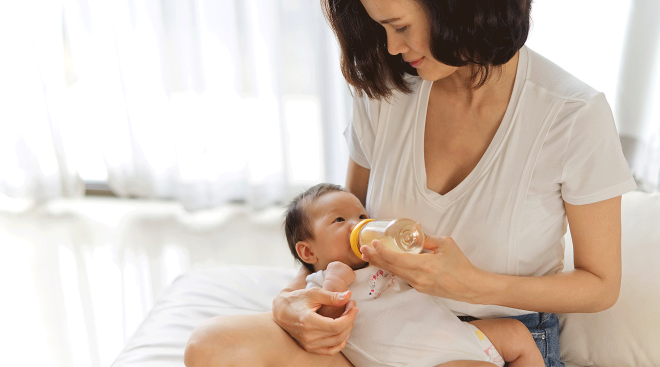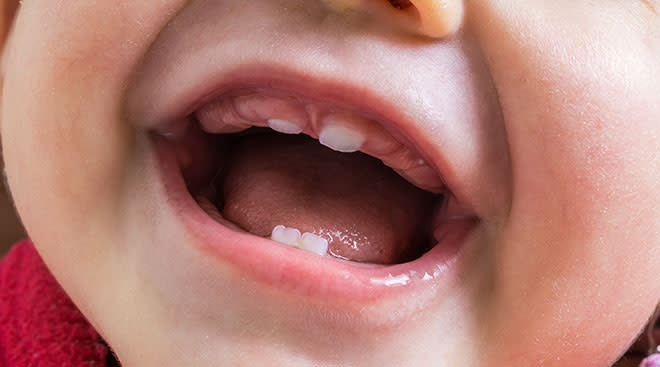How the Newborn Sucking Reflex Helps Baby
Any new parent will find that babies have an instinctual need to suck—whether it’s on the nipple of a breast or bottle, a pacifier or your finger. Not only does this sucking reflex help baby feed and grow in the first few months of life, it also helps to soothe them outside the womb. But what you should do if baby’s sucking reflex is weak, and how can you test it to begin with? Read on to learn from pediatricians how exactly the sucking reflex benefits baby, and get tips to strengthen it.
The sucking reflex is one of baby’s involuntary survival reflexes that develops in the womb, notes the American Academy of Pediatrics (AAP). It’s triggered when something (like a breast, bottle or finger) touches the roof of baby’s mouth. The newborn sucking reflex essentially “allows babies to feed, either at the breast or bottle,” explains Leigh Anne O’Connor, IBCLC, a lactation consultant in New York City. It’s “important in drawing out and controlling the flow of milk,” she adds.
Sucking vs. rooting reflex
The sucking and rooting reflexes are two of baby’s newborn reflexes, and both play big parts when it comes to feeding. The rooting reflex is when baby turns their head to look for food, and it’s triggered by something stroking their mouth or cheek, the AAP notes. Once they find the nipple of Mom’s breast or a bottle and it touches the roof of their mouth, their suck reflex is triggered. They then use “their jaw, lips and tongue to apply compression” and extract milk, explains Jacque Ordner, BSN, IBCLC, curriculum coordinator at Aeroflow Breastpumps.
According to Stanford Medicine, the suck reflex develops towards the end of the third trimester, usually between 32 and 36 weeks of pregnancy. (In fact, you may have even seen baby sucking their thumb during one of your pregnancy ultrasounds, per the AAP.) Because the newborn sucking reflex develops towards the end of pregnancy, babies born prematurely may have a “weaker or less coordinated sucking reflex at first,” Ordner says.
While the sucking reflex is one of baby’s survival instincts, it’s actually quite complex and requires newborns to suck, swallow and breathe simultaneously, according to the AAP. In other words, though they learn how to suck in the womb, babies figure out how to coordinate it with swallowing and breathing during their first few weeks of life. So it’s not surprising that even some babies born full-term need extra time to learn how to suck efficiently.
How long does the sucking reflex last?
“The sucking reflex doesn’t go away but evolves from an involuntary reflex to a controlled movement, usually between 2 to 4 months in a term baby,” explains Denise Scott, MD, an Oklahoma-based pediatrician. In other words, after the newborn phase, baby will continue to suck, but it’ll be with more control over their movements. According to O’Connor, the overall pediatric need to suck likely won’t go away until kids are 4 to 7 years old.
The newborn sucking reflex can help the development of baby’s mouth, their oral cavity structure and their teeth, says O’Connor, which makes sense as babies learn to suck before they develop other, more complex oral functions, like chewing and talking. Moreover, as Scott notes, the act of sucking—either on their thumb or a pacifier—can become a way to self-soothe.
If you’re wondering how to test baby’s suck reflex in those first few days or weeks, there is an easy way to do so. Ordner says you can touch the roof of baby’s mouth using a clean pinky finger (fingerpad up). You’ll notice they’ll start to instinctively suck on your finger.
An important step in strengthening baby’s sucking reflex is figuring out what’s causing it to be weak, O’Connor says. Is it simply prematurity, a tongue tie, birth trauma or something else at play? Ordner also suggests working with a trained professional, like a speech and language pathologist (SLP) or international board certified lactation consultant (IBCLC).
That said, certain babies are just born with a poor suck reflex, Scott says, but you can help them strengthen it. To do so, she suggests allowing baby to suck on your finger (again, fingerpad up on the roof of their mouth). Gently stroke the roof of their mouth to help trigger the suck reflex and “press down slightly on their tongue so they have to work harder to maintain suction,” she explains. If your finger starts to slip out, let baby suck it back in. Gradually, you can move your finger a little further back on baby’s tongue (but not so much that you trigger baby’s gag reflex). “While doing this, press down on the tongue repeatedly for a count of three,” Scott explains. “The idea is to improve the strength of their suction and tongue strength. An adequate suck should allow baby to suck continuously for 10 minutes without tiring.”
If you’re concerned about baby’s poor suck reflex, reach out to your child’s pediatrician. Scott and Ordner note some issues to flag include:
- Baby frequently losing their latch on the bottle or breast
- Baby getting tired quickly while sucking or falling asleep within minutes of starting to feed
- Baby getting frustrated while trying to feed
- Baby still seems to be hungry after nursing for 30 to 45 minutes (indicates they may not be sucking efficiently)
- A newborn who doesn’t want to eat or eats less than eight times in a 24-hour period
- A newborn who’s continuously hungry or wants to eat more than 14 times in a 24-hour period
- Baby doesn’t have a wet diaper every 6 to 8 hours (indicates baby may be dehydrated or not eating enough)
- Baby isn’t gaining enough weight
Additionally, if breastfeeding becomes painful; if you develop bruised, cracked or misshapen nipples, or if you don’t feel like your breasts are emptied after a feeding, it’s time to reach out for help. “Baby’s ability to effectively transfer milk from the breast hinges on how well they’re able to latch and suck,” Ordner notes. “If baby’s suck reflex is diminished or uncoordinated, they’ll have difficulty removing adequate milk during nursing, which can result in problems with weight gain for baby and problems with milk supply for mom.”
The newborn sucking reflex is an important one, as it’s what helps baby feed and grow during those first few months of life. That said, it may require some practice at first. If you’re having difficulty with baby’s feeding or breastfeeding, reach out to a provider for help—and rest assured that you and baby will eventually find a feeding rhythm that works for both of you.
Please note: The Bump and the materials and information it contains are not intended to, and do not constitute, medical or other health advice or diagnosis and should not be used as such. You should always consult with a qualified physician or health professional about your specific circumstances.
Plus, more from The Bump:
Leigh Anne O’Connor, IBCLC, LCCE, is a board-certified lactation consultant based in New York City with over 20 years of experience. She has served on the Board of the New York Lactation Consultant Association and has been an accredited La Leche League Leader for over two decades. O’Connor is also a Lamaze-certified childbirth educator.
Jacque Ordner, BSN, IBCLC , is a registered nurse, lactation consultant and the curriculum coordinator at Aeroflow Breastpumps. She’s also a mom to four and has first-hand experience with the feeding struggles families face. She earned her nursing degree from Lakeview College of Nursing, and is certified by the International Board of Lactation Consultant Examiners.
Denise Scott, MD, is a pediatrician with JustAnswer and a pediatric endocrinologist based in Oklahoma with over 30 years of experience. Certified in culinary medicine, Scott also runs the blog Feed Future Health and is the author of Feed Your Child's Future Health: Prevent Disease Before it Starts. She received her medical degree from the University of Texas Medical Branch and completed her residency at the University of Oklahoma Health Sciences Center with a fellowship at the National Institutes of Health.
American Academy of Pediatrics, Newborn Reflexes, March 2022
Stanford Medicine, Newborn Reflexes, 2023
Learn how we ensure the accuracy of our content through our editorial and medical review process.
Navigate forward to interact with the calendar and select a date. Press the question mark key to get the keyboard shortcuts for changing dates.





















































